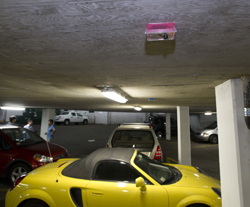Smarter Parking, Smarter City
By Mark Dwortzan
This “smart parking” scenario may be a click away, thanks to technology that Professor Christos Cassandras (ECE, SE) and systems engineering graduate student Yanfeng Geng are developing. In early August, the research team completed their first live test of a preliminary version of a smart parking system in the lower level of the 730 Commonwealth Avenue garage beneath 15 Saint Mary’s Street.
In the test, a ceiling-mounted, computer-linked sensor network continuously monitored parking spot activity and incoming reservation requests. Before entering the garage, a smartphone-equipped driver submitted an ID number and reservation request through a website. After validating the ID, the system updated a light indicator on the spot (and on a map displayed on the website) from green (unoccupied) to yellow (reserved), and, when the driver parked, to red (occupied). Once the driver departed, the system switched the light back to green and charged a parking fee to the driver’s account.
From the moment he entered the garage, the driver navigated his way to his designated spot in only about five seconds.
“In any major city center, about 30 percent of cars are cruising around looking for parking, wasting time—an average of 7.8 minutes, according to one estimate—and gas, and increasing air pollution and traffic congestion,” said Cassandras. “Our system could reduce all those problems and give cities a powerful traffic management tool.”
The project is funded as part of a National Science Foundation grant aimed at developing systems that reconfigure themselves in response to unexpected events and fast-changing conditions. The BU team is one of five pursuing ways to create “smart cities” that exploit ubiquitous wireless networking; collect information about the environment from distributed sensors; make optimal decisions about transportation, communication, power use and other complexities of urban life; and invoke actuators to execute those decisions. Cassandras and Geng’s first paper on their project, slated to appear in Proceedings of the 2011 IEEE Multi-Conference on Systems and Control, was selected as one of four finalists for the September conference’s Best Student Paper Award.
By empowering drivers to reserve parking spots remotely, the research team’s technology improves upon current “parking guidance” electronic display technology, which typically provides only parking information, such as the number of available parking spots at a nearby lot.

“The reservation component is critical as it overcomes the dilemma of whether or not to try to find a better spot, and eliminates chasing of the same spot by multiple drivers, which would create additional congestion and waste,” said Jonathan J. Jensen, director of business development at BU’s Technology Development office. “This type of system, once implemented, could also create a marketplace for parking spaces not feasible today including dynamic pricing and the ability to sell or reserve individual private parking spaces.”
While parking spots in the live test relied on ultrasound to determine their status, future garage parking spots may be equipped with technology that mechanically prevents access to vehicles without the proper ID. The researchers ultimately envision an intelligent, citywide GPS system that reserves the nearest available parking spot within a specified price range. Managing hundreds of simultaneous requests for vacant parking spots throughout a city, it would direct subscribers from their present location to the closest (and if desired, cheapest) parking spot to their destination.
Having filed a provisional patent application—the first step in the patenting process—for their smart parking technology, the research team is exploring commercialization opportunities with BU’s Technology Development Office and participating in BU’s Sustainable Neighborhood Living Laboratory (SNLL), an effort to improve the sustainability and quality of life of Boston neighborhoods such as the Back Bay.
“The SNLL will provide us with a test bed to demonstrate and test the technology in a real-world setting,” said Jensen. “A realistic test bed will accelerate development of the technology and help us to attract partners that can eventually bring the technology to market.”